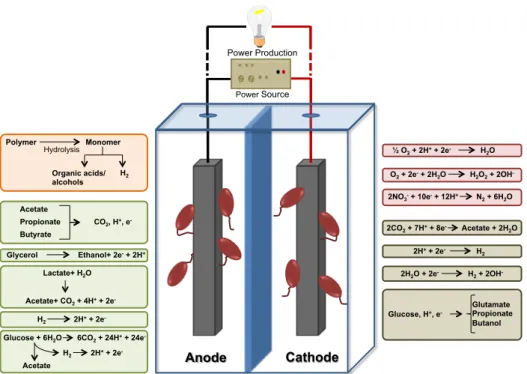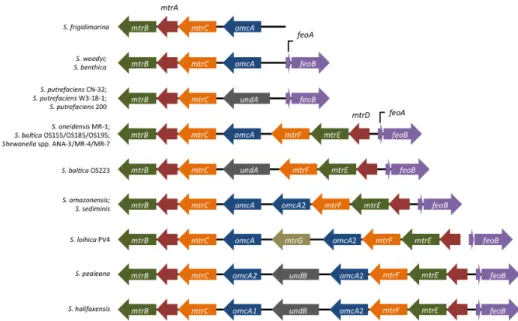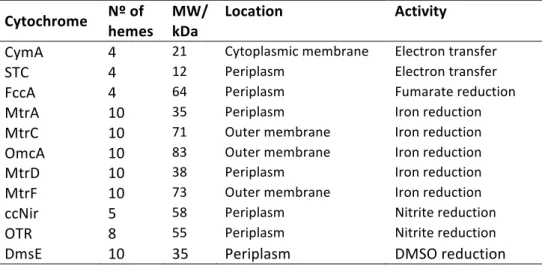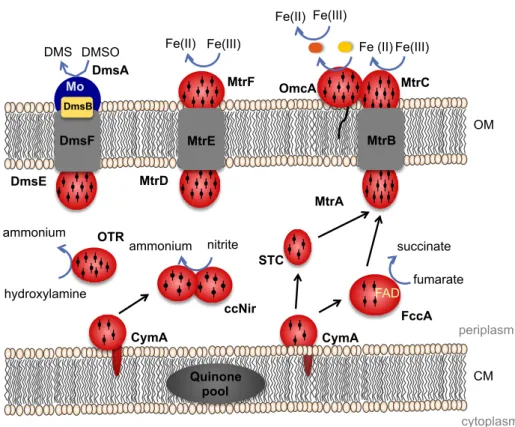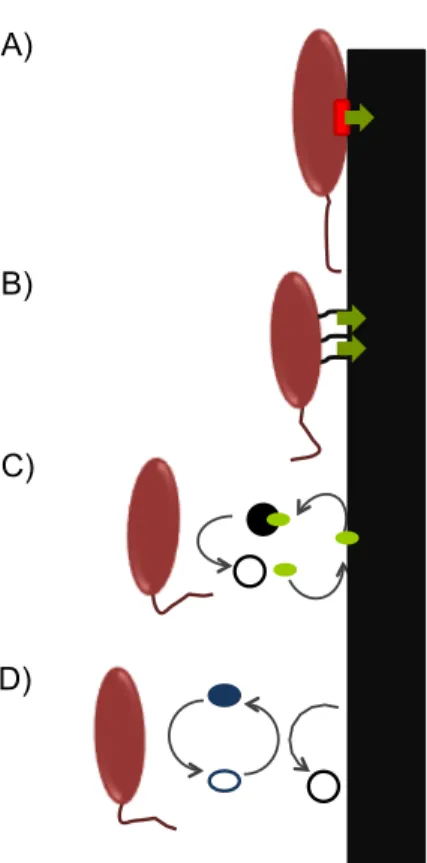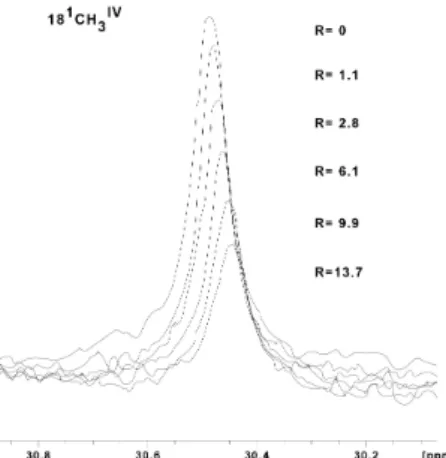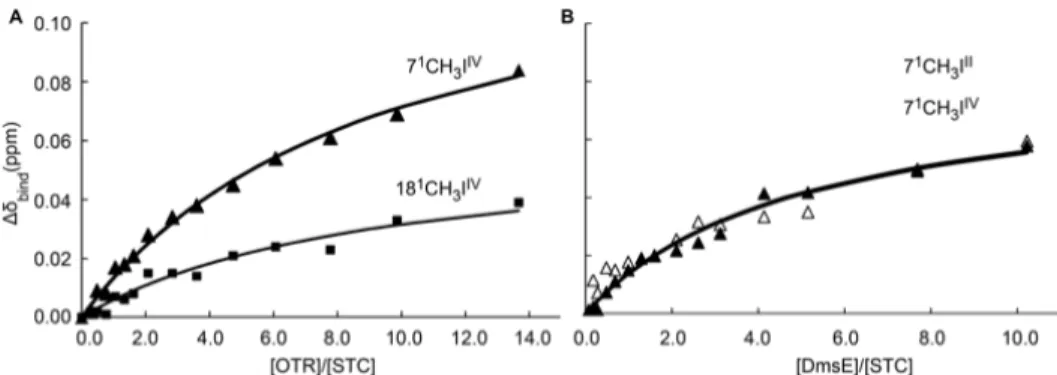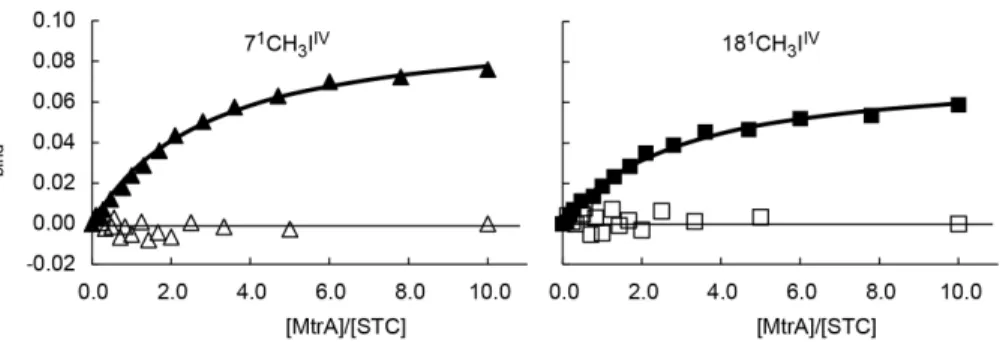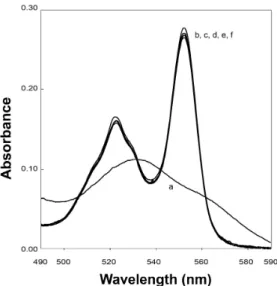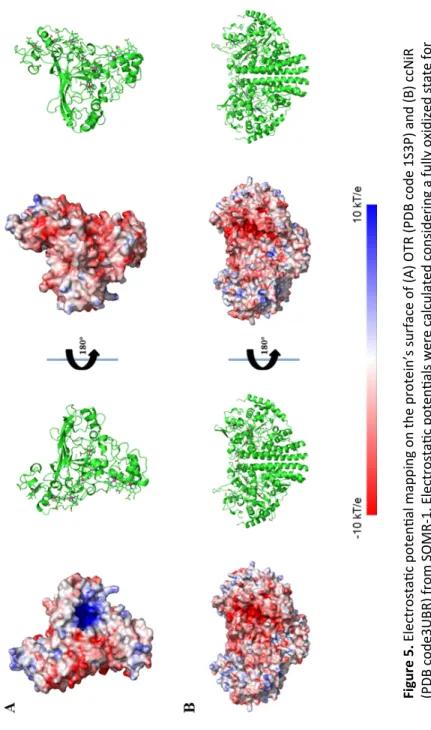Sónia Estêvão Neto
Dissertation presented to obtain the Ph.D degree in Biochemistry
Instituto de Tecnologia Química e Biológica António Xavier | Universidade Nova de Lisboa
Insert here an image with rounded corners
Oeiras,
Sónia Estêvão Neto
Dissertation presented to obtain the Ph.D degree in Biochemistry
Instituto de Tecnologia Química e Biológica António Xavier | Universidade Nova de Lisboa
Oeiras, February, 2017
Orchestrate Electron Transfer in Anaerobic
Respiratory Metabolism of Shewanella oneidensis
MR-1
Ao meu amigo Santos.
I always knew that I wanted a PhD. I wanted all the things a person can take out from this experience and the knowledge that we get during the process, not only the scientific one. This thesis and the work here developed was only possible with the help of several people that I would like to thank.
First of all I would like to thank my team of supervisors, Doctor Ricardo Louro and Doctor Catarina Paquete. If one is the “yin” the other one is the “yang”, and it was the complement of both that helped this work to be a success. I was very lucky to have had the opportunity to get the best from both of you.
To Ricardo Louro, for giving me the opportunity to work in his lab, for always believing in me and in my capabilities and most of all, for not giving up on me. Working with him for almost seven years has been quite a ride, but we always manage to have success in the tasks we proposed to do. I have to thank all the “nada temas” that kept me going in several occasions. To my co-supervisor Catarina Paquete, which is a fundamental piece in this lab and whose practical way of being helped to get the work moving when it seemed that was in a death-end.
evolution of the work. To Professor Maycock, for allowing me to do the synthesis of labelled δ-ALA in his laboratory, leading to a very nice work published in a great magazine. To Bruno Fonseca, my mentor in the Shewanella world. We were kind of a team in this lab and I am very thankful for the support that he gave me in several hard situations. Also thank you for all the joyful times we spend in 3.18.
To Alexandra, because it was always easy to work, and run the lab next to her. Thank you for the talks, the laughs and everything else.
To Ivo Saraiva, I felt very honoured in each conversation we had about complicated theoretical things of the NMR.
To all my colleagues in the Inorganic Biochemistry and NMR group during the time I spend here, that always helped lightning the spirit (most of the times) and to kept the work going.
To Isabel Pacheco for the help in managing the laboratory.
To my friends in the 5th floor that were a support for so many
circumstances and to whom I could always count: Marta, Luís, Laura, Ana, Sara, Dusica, Carla, Tiago, Nuno, Paula. To my friends in the other floors. Sónia, Mariana, Inês and all the others that I forgot to mention.
Finalmente tenho que agradecer às pessoas mais importantes da minha vida, os meus pais. Obrigada por acreditarem em mim, por me apoiarem para lá de tudo o que eu podia imaginar e por me fazerem acreditar que eu sou capaz realizar de qualquer projecto a que me proponha.
Rosa, L. F., Neto, S. E., Alves, A. S., and Louro, R. O. (2013). Electrocatálise Microbiana: Uma Plataforma Versátil para Processos Industriais Sustentáveis. Biotecnol. Soc. Port. Biotecnol. 3, 33–34. Neto, S. E., Fonseca, B. M., Maycock, C., and Louro, R. O. (2014). Analysis of the Residual Alignment of a Paramagnetic Multiheme Cytochrome by NMR. Chem. Commun. 50, 4561–4563. doi:10.1039/c3cc49135h.
Alves, M. N., Neto, S. E., Alves, A. S., Fonseca, B. M., Carrêlo, A., Pacheco, I., Paquete, C. M., Soares, C. M., Louro R. O. (2015). Characterization of the Periplasmic Redox Network that Sustains the Versatile Anaerobic Metabolism of Shewanella oneidensis MR-1. Front.
Microbiol. 6, 1–10.
doi:10.3389/fmicb.2015.00665.
Neto, S. E., Paquete, C. M., de Melo-Diogo, D., Correia, I. J., Louro, R. O. (2017) Characterization of OmcA Mutants from Shewanella oneidensis MR-1 to Investigate the Molecular Mechanisms Underpinning Electron
Transfer Across the Microbe-Electrode Interface
(submitted to Fuel Cells)
TITLE Unraveling the Molecular Mechanisms that Orchestrate Electron Transfer in Anaerobic Respiratory Metabolism of Shewanella oneidensis MR-1
AUTHOR
Sónia Estêvão Neto
COVER IMAGE DESIGN
Raquel Strecht
All rigths reserved
Contents
13 Abbreviations and Acronyms 17 Abstract 23 Resumo 29 Chapter I Introduction 61 Chapter II Characterization of the Periplasmic Redox -Network that Sustains the Versatile Anaerobic Metabolism of Shewanella oneidensis MR-1 99 Chapter III
Characterization of OmcA Mutants from Shewanella oneidensis
MR-1 to Investigate the Molecular Mechanisms Underpinning the
Electron Transfer Processes Across the Microbe-electrode Interface 135 Chapter IV Analysis of the Residual Alignment of a Paramagnetic Multiheme Cytochrome by NMR 157 Chapter V Concluding Remarks
Abbreviations and Acronyms
13C Carbon-13 A, Abs Absorbance AQDS Antraquinone 2,6-disulfonate Arg Arginine βd, Kd Dissociation constant ccm Cytochrome c maturation Δδbind Chemical shift perturbation δ-ALA δ -aminolevulinic acid DEAE Diethylaminoethanol DMSO Dimethyl sulfoxide EPR Electron paramagnetic resonance FAD Flavin adenine dinucleotide FMN Flavin mononucleotide Fw Forward GROMOS GROningen MOlecular Simulation H Histidine His-tag Histidine tag HMQC Heteronuclear multiple-quantum correlation HTP Hydroxyapatite IUPAC-IUB International union of pure and applied chemistry-International union of biochemistry and molecular biology LB Lysogeny brothM Methionine MECs Microbial electrosynthesis cells METs Microbial electrochemical technologies MFCs Microbial fuel cells MQ Menaquinone MQH2 Menaquinol NMR Nuclear magnetic resonance NOESY Nuclear Overhauser effect spectroscopy OMC Outer-membrane cytochrome OTR Octaheme tetrathionate reductase PDB Protein data bank PMS Phenazine methosulfate Pro Proline RDC Residual dipolar coupling Rev Reverse RF Riboflavine SAXS Small- angle X-ray scattering SDS-PAGE Sodium dodecyl sulphate-polyacrylamide gel electrophoresis Ser Serine SOMR-1 Shewanella oneidensis MR-1 STC Small tetraheme cytochrome TB Terrific broth Thr Threonine TMAO Trimethylamine N-oxide
TPPI Time-proportional phase incrementation UV-Vis Ultraviolet-visible spectroscopy wt Wild type
Abstract
Among the portfolio of proposals for sustainable industrial processes, Microbial Electrochemical Technologies (METs) are emerging as a versatile option with multiple potential applications, such as bioremediation of metal contamination, wastewater treatment, and electricity production in microbial fuel cells (MFC). Such systems rely on microorganisms with the ability to transfer or receive electrons from electrodes, enabling the operation of these bioelectrochemical systems.
Shewanella oneidensis MR-1 (SOMR-1) is a sedimentary Gram-negative
bacterium with a highly versatile metabolism, uniquely suited for the operation of METs. This bacterium has the ability to link its bioenergetic metabolism through the periplasm to reduce extracellular electron acceptors, like electrodes. SOMR-1 was shown to reduce a wide variety of soluble and insoluble compounds, such as metals, like iron or small molecules such as DMSO, nitrite or fumarate. However, the pathways leading to the reduction of those compounds are not completely clarified.
The present work proposes to understand specific electron transfer pathways orchestrated by this bacterium, from inside the cells to the final electron acceptors, with the goal is to clarify if the electron transfer across the periplasm is specific for each terminal electron acceptor, or if it is common for the different respiratory processes. This information will guide efforts to optimize electron transfer in METs.
The two most abundant cytochromes of SOMR-1, the small tetraheme cytochrome (STC) and FccA, are found in the periplasmic space and are responsible for two non-mixing pathways for metal reduction. Both cytochromes can transfer electrons to the membrane complex, MtrCAB, which is the major responsible for extracellular iron reduction. Interactions, followed by NMR, showed that these two proteins bind to the cytochrome facing the periplasm, MtrA, in the same or at least closely related locations, given that saturation of MtrA with FccA prevents the binding of STC.
The two existing periplasmic pathways for the reduction of iron suggested the hypothesis that both STC and FccA work as shuttles in the periplasm and may be involved in other respiratory processes. Interactions between STC or FccA with nitrite reductases and DMSO reductases, showed that STC is a promiscuous mobile redox protein responsible for the periplasmic electron transfer to iron-, nitrite- and DMSO-reductases, in contrast with FccA that does not participate in these reduction pathways.
Iron reduction by SOMR-1 is mainly associated with outer membrane cytochromes (OMC) that perform this activity by two mechanisms: a) direct contact (OMCs or nanowires), and b) indirect contact (using soluble electron shuttles that transport electrons from the cells to final electron acceptors). Among SOMR-1 OMCs, the decaheme cytochromes MtrC and OmcA from the complex MtrCAB-OmcA were shown to be essential in metal reduction. These cytochromes are located in the same
operon but they have distinct localizations and functions in the cells. OmcA is a lipoprotein found in the external part of the outer-membrane, is the most abundant cytochrome located on the outer surface of SOMR-1 cells, and is the major responsible for extracellular electron transfer to terminal electron acceptors and electron shuttles and cells attachment to electrodes.
Characterization of the interactions between OmcA and its physiological partners (iron oxides and/or mobile electron shuttles) was performed using NMR spectroscopy and stopped-flow experiments followed spectrophotometrically. Using site-directed mutagenesis, axial ligands of the hemes of OmcA were modified to investigate the effect of that change on the interaction and reactivity of OmcA with electron shuttles. The kinetics of oxidation of mutant of heme VII of OmcA by redox shuttles was different when compared with the wtOmcA, with the thermodynamic equilibrium of the reaction being established with less cytochrome oxidized. This suggests a change in the reduction potential of that heme of OmcA. Moreover, NMR spectroscopy showed that the perturbation in the heme VII is the one that most affects interaction between the cytochrome and the redox shuttle FMN. The dissociation constant for the binding between FMN and the mutant of heme VII axial ligand increase almost 5 times. However, the stoichiometry of binding was not affected, 1:2 (OmcA:FMN), remaining equal to that observed between FMN and native OmcA.
Altogether, the results indicate that mutation of heme VII changes the driving force of electron transfer towards electron shuttles and disturbs the flavin binding site near heme VII.
In order to better understand electron transfer pathways within SOMR-1, a detailed thermodynamic characterization of these complex multiheme cytochromes is needed. Although the cytochromes under study are paramagnetic, a feature that facilitates their characterization using spectroscopic methods, the majority of these multiheme cytochromes display a high number of hemes making functional characterization very difficult. With the goal to develop an effective strategy to study and characterize multiheme cytochromes, a technique was developed to assess the hemes’ organization inside the structure of cytochromes. STC, which is well characterized structurally, was used as a model protein to determine the relative orientation of the hemes within the cytochrome. Since STC hemes are low-spin paramagnetic in the oxidized state, the whole cytochrome tends to adopt a preferential orientation with respect to an external magnetic field, due to the unpaired electrons in the hemes. This enables the use of nuclear magnetic resonance (NMR) to measure residual dipolar couplings (RDCs) between NMR active nuclei in the cytochrome. The RDCs revealed that the rhombicity of the electronic structure of low-spin paramagnetic hemes determines how much each heme contributes to the preferential orientation of protein when placed in a strong magnetic field. Since the rhombicity of the electronic structure of low-spin paramagnetic hemes can be determined from the paramagnetic chemical shifts of the heme
signals, the RDCs enable the determination of the relative orientation of hemes in multiheme proteins and enzymes for which structures are not available, provided that the heme signals are assigned. Overall, the work presented in this thesis clarified the electron transfer pathways across the periplasm of SOMR-1 towards soluble and insoluble terminal electron acceptors such as iron, nitrite and DMSO. Finally, new methodologies were developed for the characterization of complex multiheme cytochromes. This knowledge is essential to understand the electron transfer processes performed by SOMR-1 and fully profit from its ability to reduce a wide diversity of compounds in its application in METs.
Resumo
As Tecnologias Electroquímicas Microbianas (METs) têm surgido como uma opção versátil no desenvolvimento de processos industriais sustentáveis. A biorremediação de locais contaminados com metais, o tratamento de águas residuais e a produção de eletricidade em células de combustível microbiano, são alguns dos exemplos deste tipo de tecnologias. Para funcionar, estes sistemas dependem de microorganismos que possuam a capacidade de transferir ou receber electrões de e para eléctrodos.
Shewanella oneidensis MR-1 (SOMR-1) é uma bactéria sedimentar,
Gram-negativa, que tem um metabolismo energético bastante versátil, sendo por isso adequada para a operação em METs. Esta bactéria consegue ligar o seu metabolismo bioenergético desde o interior da célula até ao meio extracelular, através do periplasma, de modo a reduzir aceitadores de electrões extracelulares, como por exemplo eléctrodos. SOMR-1 tem a capacidade de reduzir uma grande variedade de compostos solúveis e insolúveis, tais como metais (p.e. ferro) ou moléculas pequenas como DMSO, nitrito ou fumarato. No entanto, as vias de transferência electrónica que conduzem à redução desses compostos não estão completamente esclarecidas.
O trabalho desenvolvido nesta tese propõe-se a elucidar as vias de transferência electrónica usadas por SOMR-1, desde o interior das células, até aos aceitadores finais de electrões. O objetivo é perceber se a transferência electrónica no periplasma é específica para cada
aceitador final de electrões ou se é comum entre diferentes processos respiratórios.
Os dois citocromos mais abundantes de SOMR-1 são o STC (um pequeno citocromo tetrahémico) e o FccA. Ambos co-existem no espaço periplásmico e são responsáveis pela redução de metais através de duas vias de transferência electrónica independentes. Ambos os citocromos transferem electrões para o complexo membranar MtrCAB, o principal responsável pela redução extracelular de ferro. Interacções, seguidas por ressonância magnética nuclear (RMN), mostraram que estas duas proteínas se ligam ao MtrA no mesmo local ou em dois locais próximos, uma vez que a saturação de MtrA com FccA impede a ligação de STC. O facto de existirem duas vias de transferência electrónica independentes no periplasma, envolvidas na redução de ferro, deu origem à hipótese de que o STC e o FccA poderão funcionar como transportadores de electrões no periplasma e estarem envolvidos em outras vias respiratórias. Interações entre o STC ou o FccA com duas nitrito-reductases e uma DMSO reductase mostraram que o STC pode de facto funcionar como um transportador de electrões no periplasma uma vez que está envolvido na transferência electrónica para ferro, nitrito e DMSO-reductases. Contrariamente ao FccA que participa apenas na redução de ferro e fumarato.
A redução de ferro por SOMR-1 depende de citocromos associados à membrana externa (OMC) que reduzem os substratos através de dois mecanismos: a) contato directo (OMCs ou “nanowires”) e b) contato indirecto (transportadores solúveis de electrões transportam os
electrões das células para os aceitadores finais). Entre os OMCs de SOMR-1, os citocromos decahémicos MtrC e OmcA, do complexo MtrCAB-OmcA mostraram ser essenciais na redução de metais. Estes citocromos são codificados pelo mesmo operão mas têm localizações e funções distintas na célula. O OmcA é uma lipoproteína que se encontra na superfície extracelular da membrana externa, é o citocromo mais abundante à superfície das células e o principal responsável pela transferência electrónica para aceitadores finais e transportadores de electrões.
A caracterização das interações entre o OmcA e seus parceiros fisiológicos (óxidos de ferro e/ou transportadores de electrões) foi seguida usando RMN e experiências de fluxo interrompido. Através de mutagénese dirigida, os ligandos axiais dos hemos do OmcA foram modificados, e verificou-se o efeito dessa modificação na interacção e na reactividade do OmcA com vários transportadores de electrões. Verificou-se que a cinética de oxidação do mutante do hemo VII é diferente da observada para o wtOmcA., sendo o equilíbrio termodinâmico da reacção estabelecido com uma maior fracção de citocromo reduzido. Isto sugere uma mudança no potencial de redução do OmcA. Usando espectroscopia de RMN mostrou que a mutação no hemo VII é a que mais afeta a interacção entre o citocromo e o transportador de electrões FMN. Apesar da constante de dissociação da reacção de formação do complexo entre o FMN e o OmcA com a mutação no hemo VII aumentar aproximadamente 5 vezes, a estequiometria do complexo não foi afectada, permanecendo igual ao
observado entre o FMN e OmcA nativo (1:2 (OmcA:FMN)). Em suma, os resultados indicam que a mutação do hemo VII altera a força motriz da transferência electrónica para transportadores de electrões e afecta o local de ligação de flavinas existente perto do hemo VII.
Para melhor perceber os mecanismos de transferência electrónica orquestrados por SOMR-1, é necessária uma caracterização termodinâmica detalhada dos citocromos multihémicos envolvidos nesses porcessos. Apesar dos citocromos em estudo neste trabalho serem paramagnéticos, uma característica que facilita a sua caracterização através de métodos espectroscópicos, a maioria deles possui um elevado número de hemos, o que torna a sua caracterização funcional muito difícil. Com o objetivo de desenvolver uma estratégia eficaz para estudar e caracterizar citocromos multihémicos, foi desenvolvida uma técnica para avaliar a organização dos hemos dentro da estrutura tridimensional dos citocromos. O STC, um citocromo tetrahémico caracterizado, estrutural e funcionalmente em detalhe, foi usado como proteína modelo para determinar a orientação relativa dos hemos dentro do citocromo. Como os hemos do STC são paramagnéticos e de baixo spin no estado oxidado, o citocromo tende a adotar uma orientação preferencial quando sujeito a um campo magnético externo, devido à presença dos electrões desemparelhados nos hemos. Isto permite medir acoplamentos dipolares residuais (RDCs) entre os núcleos activos no RMN que existam no citocromo. Os RDCs revelaram que a rombicidade da estrutura electrónica dos hemos de baixo spin pode ser usada para determinar a contribuição de cada hemo
para a orientação preferencial das proteínas quando colocadas sob um campo magnético forte. Uma vez que a rombicidade da estrutura electrónica dos hemos paramagnéticos de baixo spin pode ser determinada a partir das mudanças dos desvios químicos dos sinais dos hemos, é possível, a partir dos valores dos RDCs determinar a orientação relativa dos hemos em proteínas multihémicas para as quais as estruturas não estão ainda disponíveis. Isto desde que os sinais dos hemos estejam atribuídos.
Em conclusão, o trabalho apresentado nesta tese permite esclarecer as vias de transferência electrónica ao longo do periplasma de SOMR-1 para aceitadores de electrões solúveis e insolúveis, como por exemplo ferro, nitrito e DMSO. Adicionalmente, foi desenvolvida uma nova metodologia para caracterizar citocromos multihémicos. Este conhecimento é essencial para compreender os processos de transferência electrónica realizados por SOMR-1 de modo a aproveitar plenamente a sua capacidade para ser aplicada em METs.
Contents
1. Introduction 2. Microbial Electrochemical Technologies (METs) 3. Dissimilatory Metal Reducing Organisms 3.1. Shewanella oneidensis MR-1 3.1.1. Reduction of Soluble Electron Acceptors in the Periplasm 3.1.1.1. Fumarate Reduction 3.1.1.2. Nitrogen Compounds Reduction 3.1.2. Reduction of Insoluble Electron Acceptors 4. Final Remarks 5. References Chapter I is adapted from my contributions to the paper Rosa, L. F., Neto, S. E., Alves, A. S., and Louro, R. O. (2013). Electrocatálise Microbiana: Uma Plataforma Versátil para Processos Industriais Sustentáveis. Biotecnol. Soc. Port.Biotecnol. 3, 33–34.
Chapter I
Introduction
1.
Introduction
The energy needs of the world are increasing due to the evolution of the quality of life in the developed world. Current energy generation methods are unsustainable because they consume non-renewable resources and produce greenhouse gases that are causing global warning.
A sustainable production of energy must include a carbon-neutral and renewable technology. There is a portfolio of technologies based on solar, wind and biomass that are being explored in order for the Earth to be more sustainable.
Among the several options available biomass is very promising because is a cheap resource that is used in microbial electrochemical systems with diverse purposes that will be highlighted further.
2.
Microbial Electrochemical Technologies (METs)
Microbial electrochemical technologies (METs) are unique technologies in the field of clean environmental technologies nowadays. The working principle behind METs is the same as an electrochemical cell, but METs uses microorganisms to catalyse the electrochemical reaction. The electrons involved in that reaction can be transferred to an anode by the microorganisms and used directly for electricity production (microbial fuel cells), or can be obtain from the bioremediation of contaminants
(microbial remediation cells), or used in the cathode for chemical synthesis (microbial electrolysis cells, microbial electrosynthesis) (Gregory and Lovley, 2005; Liu et al., 2004, 2010; Rabaey and Rozendal, 2010). The development of these systems combines a wide diversity of scientific areas, such as microbiology, electrochemistry, materials science and engineering.
METs can work either with microorganisms growing in the anode compartment (bioanode), in the cathode compartment (biocathode) or can work with a combination of bioanode and biocathode in a dual chamber or a single chamber device. In METs with bioanodes the microorganisms are used to oxidize an electron donor that can be organic matter, sediments, photosynthetic microorganisms, or in situ photosynthesized plant rhizodeposits (Hamelers et al., 2010) and transfer the electrons to the electrode. In biocathodes, microorganisms catalyse the oxidation of the electrode and the electrons are used by the microorganisms for example, for nitrate reduction and hydrogen production (Clauwaert et al., 2007; Rozendal et al., 2008). The phenomenon of electrons being released and accepted by microorganisms shed light into the possibility of such processes occurring naturally (Logan, 2009) and brought into light the idea for the first MET created (Potter, 1911).
In a METs the anode is maintained in anoxic conditions and a culture of the microorganisms oxidize organic or inorganic electron donors (usually waste waters or waste materials) transferring the electrons to the
electrode. The first applications were the implementation of microbial fuel cells (MFCs) for direct production of electric energy (Logan et al., 2006). MFCs have been optimized specially for the use of wastewaters, both domestic or from the industry, where the substrate and the microorganisms used were the ones naturally present in those waters (Logan and Regan, 2006). Although these MFCs could produce energy, the value of the production was not considered economically viable (Logan and Rabaey, 2012). Microorganisms used in the anode compartment of METs are called exoelectrogens, because of their ability to transfer electrons from their intracellular metabolism to extracellular acceptors using redox proteins that span across the cell membrane, delivering the electrons to the final electron acceptor.
Microbial electrosynthesis cells (MEC) are devices that use microorganisms in the cathode compartment, where they are responsible for the production of organic or inorganic chemical compounds with high market value using low value material as starting material (Rabaey and Rozendal, 2010). MEC first applications were towards the production of hydrogen, nowadays called microbial electrolysis cells (Liu et al., 2010). It will be expected that such approach, which combines microbial activity with the use of low value matter leads to a decrease in the energy spent by the system, when compared with the classic form of production, leading to more efficient synthetic processes.
Figure 1 summarizes the reactions that may occur in anodes and cathodes of METs.
Figure 1. Anodic and catodic reactions possible to occur in METs, in a dual chamber
cell. Reactions on the electrodes can be performed by planktonic cells or biofilms attached to the electrodes or by electrochemical catalysis. In the anode compartment, polymeric compounds can be degraded in more simple molecules, with an external energy source that can then be use as energy source (orange) and organic compounds can be converted generating current (green). In the cathode compartment reactions can produce energy or high value compouds, occuring spontaneously (red) or not spontaneous and have the need of an external energy source (grey). Adapted from (Logan and Rabaey, 2012).
The interest in METs has been increasing everyday (Wang and Ren, 2013) because when compared with abiotic fuel cells they are much more economic and safe (Lovley, 2006). Operations in METs generally occur at room temperature and the fuel is often of low-value and safe. Polymer Monomer Hydrolysis Organic acids/ alcohols H2 Acetate Propionate Butyrate CO2, H+, e- Glycerol Ethanol+ 2e- + 2H+ Lactate+ H2O Acetate+ CO2 + 4H+ + 2e- H2 2H+ + 2e- Glucose + 6H2O Acetate 6CO2 + 24H+ + 24e- H2 2H+ + 2e- ½ O2 + 2H+ + 2e- H2O O2 + 2e- + 2H2O H2O2 + 2OH- 2NO3- + 10e- + 12H+ N2 + 6H2O 2CO2 + 7H+ + 8e- Acetate + 2H2O 2H+ + 2e- H 2 2H2O + 2e- H2 + 2OH- Glucose, H+, e- Glutamate Propionate Butanol Anode Cathode Power Production Power Source
Opposite to abiotic fuel cells that work with fuels that are normally explosive and toxic, and need expensive catalysts to induce oxidation of the electron donor at high temperatures (Lovley, 2006).
Considering the opportunities and challenges in the development of METs, one can considered two different approaches:
1) Applications focused in the treatment of large amounts of
substrate, such as wastewater, for production of electricity, hydrogen production, or desalinization of sea water. These systems have a large dependence with the size and distances between the electrodes. Scale up of this type of cells can strongly influence its performance (Logan and Rabaey, 2012). Moreover, the microorganisms need to be able to grow inside the anode compartment, attached to the electrode, making essential the development of electrodes and membranes with a good cost/area relation and that are biocompatible (Schroder, 2012). The other point that should be taken into consideration is the reaction with atmospheric oxygen in the cathode compartment. Cheap catalysts with high efficiency and durability and membranes that do not leak oxygen to the anode are fundamental to construct efficient systems (Rosa et al., 2013).
2) Applications towards the production of high value
Such applications are a challenge because normally the goal is a pure high quality product, which often needs extra steps of production and purification, increasing the costs of the production. To overcome this challenge, there is the need to identified strains able to synthesize the desired product in proper quantity and quality, minimizing the purification steps.
The use of METs in the future has several challenges ahead. However, there is no doubt about the advantages of the use of these technologies in order to close the life cycle of materials. In fact the fuels for METs are residues that otherwise would need to be treated, this way are being used to be converted in electric energy or high value compounds. Therefore introduction of METs in industrial process can strongly diminish the ecological impact of the wide diversity of electrochemical processes.
Research has been concentrating efforts in understanding microbial metabolism towards electrodes of METs with special attention to dissimilatory metal reducing organisms.
3.
Dissimilatory Metal Reducing Organisms
Biochemical and microbiological knowledge regarding microorganism metabolism directs the efforts to implement METs using bacteria isolated from marine environments. The proof of concept of METs has
been shown mainly with power generation in MFC using organisms from Proteobacteria, Firmicutes, Acidobacteria phyla and also organisms from the Archaea and Eukarya domains of life (Logan, 2009). Among the Proteobacteria group, Shewanella oneidensis MR-1 (SOMR-1) was the first organism that showed electrical current production in a MFC, using lactate as electron donor and the electrode as electron acceptor in the absence of soluble redox mediators (Kim et al., 2002). Years later, SOMR-1 mutants have produced more current than the wild type (Bretschger et al., 2007), showing that either electron flow in this bacteria can redirect towards specific electron acceptors or biofilms can be induced to increase adhesion of bacteria to electrodes. Geobacter strains, also from the Proteobacteria group, have been widely used in MFCs for current production (Bond et al., 2002; Bond and Lovley, 2003). Geobacter oxidize organic electron donors to carbon dioxide, normally combined with respiration of insoluble final electron acceptors.
Desulfuromonas acetoxidans, Pseudomonas aeruginosa, Escherichia coli, Rhodopseudomonas palustris and Desulfovibrio desulfuricans are other
examples of Proteobacteria that showed the ability to transfer electrons extracellularly and were used in electrochemical systems (Logan, 2009).
Clostridium butyricum EG3 was the first Gram-positive shown to
produce electrical current in a MFC (Park et al., 2001). Several years latter Thermincola sp. strain JR, also a Gram-positive bacteria, was identified as the dominant organism in a MFC working in thermophilic
conditions, when acetate was used as electron donor (Wrighton et al., 2008). Organisms from the domains Archaea and Eukarya also showed electric current production in MFCs (Prasad et al., 2007; Abrevaya et al., 2011). Although there is a wide diversity of microorganisms able to be used in efficient METs, a marine, or salt tolerant organism like Shewanella is more adequate. Shewanella oneidensis MR-1 is the most versatile microorganism, able to use a diversity of final electrons acceptors (Logan, 2009), and therefore will be the object of study in this work.
3.1. Shewanella oneidensis MR-1
Species from the genus Shewanella are facultative Gram-negative bacteria, belonging to the γ-Proteobacteria pylum (MacDonell and Colwell, 1985). There are sixty-three different Shewanella species
recognized until now (accordingly to LPSN; http://www.bacterio.net,
September 2016, Appendix 1- Figure 1) and the majority are found in aquatic and sedimentary environments, where organic matter is actively degraded. Such environments vary in nutrient composition, salinity, temperature, redox potential and pressure and these differences in growth conditions produce evolutionary pressure that results in different genotypes between the species (Venkateswaran et al., 1999; Hau and Gralnick, 2007). Among the ones with the genome sequenced, a core genome of 2137 genes is common to all of them (Fredrickson et
al., 2008). Several organisms from this genus have demonstrated preferential metabolism towards metallic electron acceptors, rather than sugars and aminoacids (Nealson et al., 1995), and in fact, the metal reductase containing locus is conserved among several strains of
Shewanella (Figure 2).
Figure 2. Locus encoding the genes responsible for metal reduction in Shewanella
species. Adapted from (Fredrickson et al., 2008).
Shewanella oneidensis MR-1 (SOMR-1), formerly known as Alteromonas putrefaciens MR-1, was isolated from anaerobic sediments of Oneida
Lake (New York) and it was discovered due to an increase in the accumulation of Mn(II) during summer months (Myers and Nealson, 1988) in opposition to the deposition of Mn(IV) during the winter. SOMR-1 was identified as the microorganism present in the sediments responsible for the reduction of manganese during the summer, as a
consequence of the optimal growth temperature for this microorganism.
SOMR-1 has a very versatile metabolism and its genome suggests multiple pathways for catabolism of organic acids, fatty acids, aminoacids, peptides and nucleotides, strongly suggesting the ability of this microorganism to consume a variety of organic matter (Fredrickson et al., 2008). Genome sequencing identified 41 possible c-type cytochromes, based on the heme binding motif (CXXCH) (Meyer et al., 2004), which are strongly connected with the versatile metabolism observed in SOMR-1. Electron transfer pathways in SOMR-1 occur towards a wide variety of final electron acceptors, such as oxygen, fumarate, nitrate, nitrite, thiosulfate, sulphur, selenium, trimethylamine N-oxide, dimethyl sulfoxide, anthraquinone-2,6-disolfunate, and soluble and insoluble metals, such as iron, manganese, uranium, chromium, cobalt, technetium and vanadium (Nealson and Saffarini, 1994; Liu et al., 2002; Carpentier et al., 2003; Hau et al., 2008). Moreover, SOMR-1 was the first microorganism shown to perform direct electron transfer to glassy carbon electrodes in MFC (Kim et al., 1999).
Extracellular electron transfer mechanisms were shown to rely on c-type cytochromes that are either located in the cytoplasmic membrane, soluble in the periplasm or attached to the outer-membrane, allowing SOMR-1 to reduce extracellular compounds (Meyer et al., 2004; Shi et al., 2007). Electron transfer processes can occur in the periplasmic space, towards the reduction of soluble electron acceptors (Leys et al.,
1999; Gao et al., 2009), or extracellular towards the reduction of insoluble electron acceptors, and are linked to the activity of multiheme cytochromes that shuttles electrons between the cytoplasmic membrane and the external cell wall (Table 1). Table 1. Multiheme cytochromes involved in electron transfer pathways in SOMR-1. Cytochrome Nº of hemes MW/ kDa Location Activity
CymA 4 21 Cytoplasmic membrane Electron transfer
STC 4 12 Periplasm Electron transfer
FccA 4 64 Periplasm Fumarate reduction
MtrA 10 35 Periplasm Iron reduction
MtrC 10 71 Outer membrane Iron reduction
OmcA 10 83 Outer membrane Iron reduction
MtrD 10 38 Periplasm Iron reduction
MtrF 10 73 Outer membrane Iron reduction
ccNir 5 58 Periplasm Nitrite reduction
OTR 8 55 Periplasm Nitrite reduction
DmsE 10 35 Periplasm DMSO reduction
3.1.1.
Reduction of Soluble Electron Acceptors
in the Periplasm
Electrons from the intracellular metabolism enter the periplasmic space, from the inner membrane, via a tetraheme c-type cytochrome called CymA. This cytochrome shares similarity with members from the quinol dehydrogenases family and is reduced by taking electrons from the quinone pool in the inner membrane (Myers and Myers, 1997). Deletion of CymA from SOMR-1 genome disables this microorganism to use
several substrates as final electron acceptors, including soluble (fumarate, nitrate, nitrite, selenium) and insoluble (Fe(III)/Mn(IV) oxides and DMSO) compounds (Shi et al., 2007). Although there are some genes in SOMR-1 genome that share homology with the one of CymA, the ability of the proteins encoded by them to substitute CymA is very low, with the exception of SirCD that can recover the microorganism ability to reduce fumarate and DMSO (Cordova et al., 2011). CymA is known to interact with a wide variety of proteins involved in reduction of several compounds, such as, nitrate, nitrite, fumarate and iron (Cordova et al., 2011), and Figure 3 shows the interactions already studied between CymA and physiological partners.
Figure 3. Schematic representation of electron transfer pathways of Shewanella
oneidensis MR-1.
The two most abundant c-type cytochromes found in the periplasmic space of SOMR-1 are FccA, which is responsible for the catalytic reduction of fumarate (Leys et al., 1999) and a small tetraheme cytochrome (STC) that works as a electron carrier across the periplasm (Fonseca et al., 2013; Sturm et al., 2015).
3.1.1.1.
Fumarate Reduction
FccA was identified as the unique fumarate reductase of this organism (Taylor et al., 1999). This enzyme performs the reduction of fumarate to CymA Quinone pool fumarate succinate DMSO DMS DmsE FccA FAD STC CM OM periplasm cytoplasm DmsF DmsB Mo DmsA hydroxylamine ammonium OTR MtrD MtrF MtrE Fe(III) Fe(II) ccNir ammonium nitrite Fe(III) Fe (II) MtrA MtrC MtrB OmcA Fe(II) Fe(III) CymA
succinate in a two-electron/two-proton reaction. Structural studies showed that FccA is composed by three domains: a heme domain with four bis-histidine coordinated hemes; a domain with a non-covalently bound flavin adenine dinucleotide group (FAD) where the fumarate reduction occurs; and a clamp domain, that links the two domains. It was proposed that this clamp domain contributes to the formation of two different conformations depending on the presence and absence of the substrate (Leys et al., 1999). Previous work on FccA showed that hemes I and II are the ones that receive electrons from the electron donor, whereas the fourth heme that is buried within the protein close to the FAD domain is proposed to be responsible to transfer electrons to the catalytic site (Rothery et al., 2003). The in vitro activity of FccA to reduce fumarate to succinate was studied with the enzyme from S.
frigidimarina where two aminoacids were described as having a crucial
role in this process: Histine 61 that is the distal axial ligand of the heme IV, and Arg402 (Rothery et al., 2003; Pankhurst et al., 2006). Histidine 61 is highly conserved in the family of fumarate/succinate dehydrogenases, and kinetic and electrochemical characterization of H61A and H61M mutant forms of FccA showed that these mutations affect the catalytic activity of the enzyme and proved that the electron transfer for the FAD is rate-limiting (Rothery et al., 2003; Pankhurst et al., 2006). Moreover, kinetic and structural evidence showed that Arg402, located near the active site acid/base catalyst for fumarate reduction is vital for the enzyme activity in S. frigidimarina. Since Arg402 is also a well conserved residue among fumarate reductases, it is believed to fulfil the same role in all the members of this family (Pankhurst et al., 2006).
3.1.1.2.
Nitrogen Compounds Reduction
Reduction of nitrogen compounds occurs in the periplasmic space and two different enzymes were identified to perform this type of reactions: the octaheme tetrathionate reductase (OTR) and the cytochrome-c nitrite reductase (ccNir) (Mowat et al., 2004; Youngblut et al., 2014). OTR was originally identified as a soluble tetrathionate reductase, but activity assays showed that this protein has the ability to reduce a wide range of nitrogen substrates (Atkinson et al., 2007). It is composed by a chain of seven low spin hemes, that provide efficient electron transfer to the catalytic heme, which is a penta-coordinated high-spin heme axially coordinated by a lysine (Mowat et al., 2004). Coordination of the catalytic heme is unique among these types of enzymes because the lysine is not part of the heme-binding motif of that heme.
ccNir is a soluble periplasmic cytochrome, which is a dimeric pentaheme nitrite reductase. It has a catalytic heme in each monomer that is, like OTR, lysine coordinated. The penta-coordination of the catalytic heme allows the substrate to bind to the open position and the six-electron reduction of nitrite to ammonia occurs with the substrate and intermediates, always bound to the catalytic heme during catalysis (Youngblut et al., 2012).
Studies of OTR and ccNir showed that these two cytochromes are biased towards similar electron acceptors and have similarities in the coordination of the catalytic hemes and in the catalytic mechanism. The 3D crystal structures of the two cytochromes are considerably different,
however the heme arrangement is similar between the two proteins. Previous work showed that ccNir can be reduced by CymA (Gao et al., 2009), but is not yet clear how electrons reach OTR.
3.1.2.
Reduction
of
Insoluble
Electron
Acceptors
The known pathways for reduction of insoluble electron acceptors, outside of the cells, also start with electrons entering the periplasmic space via CymA. Recent findings suggest the existence of two separate pathways of electron flow across the periplasm to the outside of the cell, which rely on the two most abundant cytochromes of SOMR-1, the small tetraheme cytochrome (STC) and FccA (Fonseca et al., 2013). These two pathways seem to be redundant for extracellular reduction by the outer-membrane complex MtrCAB-OmcA, since both STC and FccA can transfer electrons to MtrA, the decaheme cytochrome of the complex facing the periplasmic space (Figure 3) (Fonseca et al., 2013). The MtrCAB-OmcA complex is encoded by the operon mtrCAB-omcA and contains three homologues in SOMR-1 genome. These are the complexes encoded by the operons mtrDEF (proposed to have a similar role to MtrCAB–OmcA complex due to its high similarity), dmsEFABGH (responsible for the extracellular respiration of DMSO) and the third containing the genes SO_4360 and SO_4359 (Coursolle and Gralnick, 2010). The OMCs MtrC and OmcA from the complex MtrCAB-OmcA were shown to be essential for metal reduction (Coursolle and Gralnick,
2010). Although they are located in the same operon, they have distinct localizations and functions: MtrC is part of the complex, being buried in the membrane beta-barrel (MtrB), and receives electrons from the periplasmic cytochrome MtrA; OmcA is a lipoprotein found in the external part of the outer-membrane and receives electrons from MtrC (Lower et al., 2009). Both MtrC and OmcA interact with the same electron shuttles, but with different stoichiometry, one molecule of MtrC binds only one molecule of FMN and one molecule of OmcA can bind 2 molecules of FMN (Paquete et al., 2014a). This phenomenon is probably related with the functionality of these OMC that were shown to exist with different stoichiometry in SOMR-1 membranes 1:1 or 2:1 of OmcA:MtrC (Ross et al., 2007; Zhang et al., 2009). This two possible stoichiometry ratios between the two OMCs along with studies showing different distribution patterns of OmcA and MtrC at the cell surface (Lower et al., 2009) support the idea that OmcA has the ability to move in the surface of SOMR-1, receiving electrons from MtrC and transferring them to electron shuttles (Paquete et al., 2014a). This movement contributes to the discharge of electrons, and allows the modulation of the charge of cell surface patches, controlling cell adhesion to electrode surfaces or to other cells (Lower et al., 2009; Paquete et al., 2014a).
The extracellular respiration of SOMR-1 to insoluble compounds relies on these outer-membrane cytochromes and may occur through two mechanisms: a) direct contact via OMC or nanowires that are extensions of the outer-membrane of SOMR-1, and b) indirect contact through
soluble electron shuttles that transport electrons from cells to final electron acceptors (Figure 4) (Gralnick and Newman, 2007).
Figure 4. Mechanisms for extracellular respiration. From top: A) The substrate (solid
black rectangle) is reduced directly by the outer-membrane cytochrome (red rectangle) in the cell surface; B) Conductive nanowires form a bridge from the cell to the solid electron acceptor that is reduced. C) and D) Indirect electron transfer. Small molecules, such as metal chelators C) in which the substrate is brought to the cell by the chelators (green oval) to be reduced and electron shuttles D) in which the electron shuttle (blue oval) transfer the electrons between the cell and the substrate. Adapted from (Gralnick and Newman, 2007). A) B) C) D)
4.
Final Remarks
Bacteria that have the ability to populate the electrodes in METs take advantage of the several strategies they can use, such as versatility towards electron donors, ability to reduce several electron acceptors, and secondary metabolites production, in order to increase electric current production. The understanding of the mechanisms sustaining this phenomenon is essential to increase biocompatibility, design and proper materials for the construction of efficient electrodes.
The work of this thesis aims to study in detail several cytochromes involved in electron transfer towards soluble and insoluble electron acceptors, with the goal to improve their role in METs for electricity production or in the synthesis of high value products. The advantage in the implementation of such systems is a progressive integration of METs in industrial environment towards a more sustainable use of resources.
5.
References
Abrevaya, X. C., Sacco, N., Mauas, P. J. D., and Cortón, E. (2011). Archaea-based Microbial Fuel Cell Operating at High Ionic Strength Conditions. Extremophiles 15, 633–642. doi:10.1007/s00792-011-0394-z. Alves, M. N., Neto, S. E., Alves, A. S., Fonseca, B. M., Carrêlo, A., Pacheco, I., et al. (2015). Characterization of the periplasmic redoxnetwork that sustains the versatile anaerobic metabolism of Shewanella oneidensis MR-1. Front. Microbiol. 6, 1–10. doi:10.3389/fmicb.2015.00665. Atkinson, S. J., Mowat, C. G., Reid, G. A., and Chapman, S. K. (2007). An Octaheme c-type Cytochrome From Shewanella oneidensis Can Reduce Nitrite and Hydroxylamine. FEBS Lett. 581, 3805–3808. doi:10.1016/j.febslet.2007.07.005. Bond, D. R., Holmes, D. E., Tender, L. M., and Lovley, D. R. (2002). Electrode-Reducing Microorganisms That Harvest Energy from Marine Sediments. Science (80-. ). 295, 483–485. doi:10.1126/science.1066771. Bond, D. R., and Lovley, D. R. (2003). Electricity Production by Geobacter sulfurreducens Attached to Electrodes. Appl. Environ. Microbiol. 69, 1548–1555. doi:10.1128/AEM.69.3.1548. Bretschger, O., Obraztsova, A., Sturm, C. A., In, S. C., Gorby, Y. A., Reed, S. B., et al. (2007). Current Production and Metal Oxide Reduction by Shewanella oneidensis MR-1 Wild Type and Mutants. Appl. Environ. Microbiol. 73, 7003–7012. doi:10.1128/AEM.01087-07. Carpentier, W., Sandra, K., Smet, I. De, Brigé, A., Smet, L. De, and Beeumen, J. Van (2003). Microbial Reduction and Precipitation of Vanadium by Shewanella oneidensis. Appl. Environ. Microbiol. 69, 3636–3639. doi:10.1128/AEM.69.6.3636.
Clauwaert, P., Rabaey, K., Aelterman, P., De Schamphelaire, L., Pham, T. H., Boeckx, P., et al. (2007). Biological Denitrification in Microbial Fuel Cells. Environ. Sci. Technol. 41, 3354–3360. doi:10.1021/es062580r. Cordova, C. D., Schicklberger, M. F. R., Yu, Y., and Spormann, A. M. (2011). Partial Functional Replacement of CymA by SirCD in Shewanella oneidensis MR-1. J. Bacteriol. 193, 2312–2321. doi:10.1128/JB.01355-10. Coursolle, D., and Gralnick, J. A. (2010). Modularity of the Mtr Respiratory Pathway of Shewanella oneidensis Strain MR-1. Mol. Microbiol. 77, 995–1008. doi:10.1111/j.1365-2958.2010.07266.x. Fonseca, B. M., Paquete, C. M., Neto, S. E., Pacheco, I., Soares, C. M., and Louro, R. O. (2013). Mind the Gap: Cytochrome Interactions Reveal Electron Pathways Across the Periplasm of Shewanella oneidensis MR-1. Biochem. J. 449, 101–108. doi:10.1042/BJ20121467. Fredrickson, J. K., Romine, M. F., Beliaev, A. S., Auchtung, J. M., Driscoll, M. E., Gardner, T. S., et al. (2008). Towards Environmental Systems Biology of Shewanella. Nat. Rev. Microbiol. 6, 592–603. doi:10.1038/nrmicro1947. Gao, H., Yang, Z. K., Barua, S., Reed, S. B., Romine, M. F., Nealson, K. H., et al. (2009). Reduction of Nitrate in Shewanella oneidensis Depends on Atypical NAP and NRF Systems with NapB as a
Preferred Electron Transport Protein from CymA to NapA. ISME J. 3, 966–976. doi:10.1038/ismej.2009.40. Gralnick, J. A., and Newman, D. K. (2007). Extracellular respiration. Mol. Microbiol. 65, 1–11. doi:10.1111/j.1365-2958.2007.05778.x. Gregory, K. B., and Lovley, D. R. (2005). Remediation and Recovery of Uranium from Contaminated Subsurface Environments with Electrodes. Environ. Sci. Technol. 39, 8943–8947. doi:10.1021/es050457e. Hamelers, H. V. M., Ter Heijne, A., Sleutels, T. H. J. A., Jeremiasse, A. W., Strik, D. P. B. T. B., and Buisman, C. J. N. (2010). New Applications and Performance of Bioelectrochemical Systems. Appl. Microbiol. Biotechnol. 85, 1673–1685. doi:10.1007/s00253-009-2357-1. Hau, H. H., Gilbert, A., Coursolle, D., and Gralnick, J. A. (2008). Mechanism and Consequences of Anaerobic Respiration of Cobalt by Shewanella oneidensis strain MR-1. Appl. Environ. Microbiol. 74, 6880–6886. doi:10.1128/AEM.00840-08. Hau, H. H., and Gralnick, J. A. (2007). Ecology and Biotechnology of the Genus Shewanella. Annu. Rev. Microbiol. 61, 237–258. doi:10.1146/annurev.micro.61.080706.093257. Kim, B. H., Ikeda, T., Park, H. S., Kim, H. J., Hyun, M. S., Kano, K., et al. (1999). Electrochemical Activity of an Fe(III)-Reducing Bacterium, Shewanella putrefaciens MR-1, in the Presence of Alternative
Electron Acceptors. Biotechnol. Tech. 13, 475–478. doi:10.1023/A:1008993029309. Kim, H. J., Park, H. S., Hyun, M. S., Chang, I. S., Kim, M., and Kim, B. H. (2002). A mediator-less microbial fuel cell using a metal reducing bacterium, Shewanella putrefaciens. Enzyme Microb. Technol. 30, 145–152. doi:10.1016/S0141-0229(01)00478-1. Leys, D., Tsapin, A. S., Nealson, K. H., Meyer, T. E., Cusanovich, M. A., and van Beeumen, J. J. (1999). Structure and Mechanism of the Flavocytochrome c Fumarate Reductase of Shewanella putrefaciens MR-1. Nat. Struct. Biol. 6, 1113–1117. Available at: http://www.nature.com/nsmb/journal/v6/n12/abs/nsb1299_1113. html [Accessed November 18, 2013]. Liu, C., Gorby, Y. A., Zachara, J. M., Fredrickson, J. K., and Brown, C. F. (2002). Reduction Kinetics of Fe(III), Co(III), U(VI), Cr(VI), and Tc(VII) in Cultures of Dissimilatory Metal-Reducing Bacteria. Biotechnol. Bioeng. 80, 637–649. doi:10.1002/bit.10430. Liu, H., Hu, H., Chignell, J., and Fan, Y. (2010). Microbial Electrolysis: Novel Technology for Hydrogen Production From Biomass. Biofuels 1, 129–142. doi:10.4155/bfs.09.9. Liu, H., Ramnarayanan, R., and Logan, B. E. (2004). Production of Electricity During Wastewater Treatment Using a Single Chamber Microbial Fuel Cell. Environ. Sci. Technol. 38, 2281–2285. doi:10.1021/es034923g.
Logan, B. E. (2009). Exoelectrogenic Bacteria that Power Microbial Fuel Cells. Nat. Rev. Microbiol. 7, 375–381. doi:10.1038/nrmicro2113. Logan, B. E., Hamelers, B., Rozendal, R., Schröder, U., Keller, J., Freguia, S., et al. (2006). Microbial Fuel Cells: Methodology and Technology. Environ. Sci. Technol. 40, 5181–5192. doi:10.1021/es0605016. Logan, B. E., and Rabaey, K. (2012). Conversion of Wastes into Bioelectricity and Chemicals by Using Microbial Electrochemical Technologies. Science (80-. ). 337, 686–690. doi:10.1126/science.1217412. Logan, B. E., and Regan, J. M. (2006). Microbial Fuel Cells- Challenges and Applications. Environ. Sci. Technol. 40, 5172–5180. doi:10.1021/es0627592. Lovley, D. R. (2006). Bug Juice: Harvesting Electricity with Microorganisms. Nat. Rev. Microbiol. 4, 497–508. doi:10.1038/nrmicro1442. Lower, B. H., Yongsunthon, R., Shi, L., Wildling, L., Gruber, H. J., Wigginton, N. S., et al. (2009). Antibody Recognition Force Microscopy Shows that Outer Membrane Cytochromes OmcA and MtrC Are Expressed on the Exterior Surface of Shewanella oneidensis MR-1. Appl. Environ. Microbiol. 75, 2931–2935. doi:10.1128/AEM.02108-08. MacDonell, M. T., and Colwell, R. R. (1985). Phylogeny of the
Vibrionaceae, and Recommendation for Two New Genera, Listonella and Shewanella. Syst. Appl. Microbiol. 6, 171–182. doi:10.1016/S0723-2020(85)80051-5. Meyer, T. E., Tsapin, A. I., Vandenberghe, I., de Smet, L., Frishman, D., Nealson, K. H., et al. (2004). Identification of 42 Possible Cytochrome c Genes in the Shewanella oneidensis Genome and Characterization of Six Soluble Cytochromes. Omi. A J. Integr. Biol. 8, 57–77. doi:10.1089/153623104773547499. Mowat, C. G., Rothery, E., Miles, C. S., McIver, L., Doherty, M. K., Drewette, K., et al. (2004). Octaheme Tetrathionate Reductase is a Respiratory Enzyme with Novel Heme Ligation. Nat. Struct. Mol. Biol. 11, 1023–1024. doi:10.1038/nsmb827. Myers, C. R., and Myers, J. M. (1997). Cloning and Sequence of cymA, a Gene Encoding a Tetraheme Cytochrome c Required for Reduction of Iron(III), Fumarate, and Nitrate by Shewanella putrefaciens MR-1. J. Bacteriol. 179, 1143–1152. Myers, C. R., and Nealson, K. H. (1988). Bacterial Manganese Reduction and Growth with Manganese Oxide as the Sole Electron Acceptor. Science (80-. ). 240, 1319–1321. Available at: http://science.sciencemag.org/content/240/4857/1319.abstract. Nealson, K. H., Moser, D. P., and Saffarini, D. A. (1995). Anaerobic Electron Acceptor Chemotaxis in Shewanella putrefaciens. Appl. Environ. Microbiol. 61, 1551–1554.
Nealson, K. H., and Saffarini, D. (1994). Iron and Manganese in Anaerobic Respiration: Environmental Significance, Physiology, and Regulation. Annu. Rev. Microbiol. 48, 311–343. doi:10.1146/annurev.micro.48.1.311. Pankhurst, K. L., Mowat, C. G., Rothery, E. L., Hudson, J. M., Jones, A. K., Miles, C. S., et al. (2006). A Proton Delivery Pathway in the Soluble Fumarate Reductase from Shewanella frigidimarina. J. Biol. Chem. 281, 20589–20597. doi:10.1074/jbc.M603077200. Paquete, C. M., Fonseca, B. M., Cruz, D. R., Pereira, T. M., Pacheco, I., Soares, C. M., et al. (2014a). Exploring the Molecular Mechanisms of Electron Shuttling Across the -Microbe/Metal Space. Front. Microbiol. 5, 318–330. doi:10.3389/fmicb.2014.00318. Paquete, C. M., Saraiva, I. H., and Louro, R. O. (2014b). Redox Tuning of the Catalytic Activity of Soluble Fumarate Reductases from Shewanella. Biochim. Biophys. Acta 1837, 717–725. doi:10.1016/j.bbabio.2014.02.006. Park, H. S., Kim, B. H., Kim, H. S., Kim, H. J., Kim, G. T., Kim, M., et al. (2001). A Novel Electrochemically Active and Fe (III)-reducing Bacterium Phylogenetically Related to Clostridium butyricum Isolated from a Microbial Fuel Cell. Anaerobe 7, 297–306. doi:10.1006/anae.2001.0399. Potter, M. C. (1911). Electrical Effects Accompanying the Decomposition of Organic Compounds. Proc. R. Soc. London. Ser. B, Contain. Pap. a
Biol. Character 84, 260–276. Available at: http://rspb.royalsocietypublishing.org/content/84/571/260.abstrac t. Prasad, D., Arun, S., Murugesan, M., Padmanaban, S., Satyanarayanan, R. S., Berchmans, S., et al. (2007). Direct Electron Transfer With Yeast Cells and Construction of a Mediatorless Microbial Fuel Cell. Biosens. Bioelectron. 22, 2604–2610. doi:10.1016/j.bios.2006.10.028. Rabaey, K., and Rozendal, R. A. (2010). Microbial Electrosynthesis- Revisiting the Electrical Route for Microbial Production. Nat. Rev. Microbiol. 8, 706–716. doi:10.1038/nrmicro2422. Rosa, L. F., Neto, S. E., Alves, A. S., and Louro, R. O. (2013). Electrocatálise Microbiana: Uma Plataforma Versátil para Processos Industriais Sustentáveis. Biotecnol. Soc. Port. Biotecnol. 3, 33–34. Ross, D. E., Ruebush, S. S., Brantley, S. L., Hartshorne, R. S., Clarke, T. A., Richardson, D. J., et al. (2007). Characterization of Protein-Protein Interactions Involved in Iron Reduction by Shewanella oneidensis MR-1. Appl. Environ. Microbiol. 73, 5797–5808. doi:10.1128/AEM.00146-07. Rothery, E. L., Mowat, C. G., Miles, C. S., Walkinshaw, M. D., Reid, G. A., and Chapman, S. K. (2003). Histidine 61: An Important Heme Ligand in the Soluble Fumarate Reductase from Shewanella frigidimarina. Biochemistry 42, 13160–13169. doi:10.1021/bi030159z.
Rozendal, R. A., Jeremiasse, A. W., Hamelers, H. V. M., and Buisman, C. J. N. (2008). Hydrogen Production with a Microbial Biocathode. Environ. Sci. Technol. 42, 629–634. doi:Doi 10.1021/Es071720+. Schroder, U. (2012). Microbial fuel cells and microbial electrochemistry: Into the next century! ChemSusChem 5, 959–961. doi:10.1002/cssc.201200319. Shi, L., Squier, T. C., Zachara, J. M., and Fredrickson, J. K. (2007). Respiration of Metal (Hydr)Oxides by Shewanella and Geobacter: A Key Role for Multihaem c-type Cytochromes. Mol. Microbiol. 65, 12–20. doi:10.1111/j.1365-2958.2007.05783.x. Sturm, G., Richter, K., Doetsch, A., Heide, H., Louro, R. O., and Gescher, J. (2015). A Dynamic Periplasmic Electron Transfer Network Enables Respiratory Flexibility Beyond a Thermodynamic Regulatory Regime. ISME J., 1–10. doi:10.1038/ismej.2014.264. Taylor, P., Pealing, S. L., Reid, G. A., Chapman, S. K., and Walkinshaw, M. D. (1999). Structural and Mechanistic Mapping of a Unique Fumarate Reductase. Nat. Struct. Biol. 6, 1108–1112. doi:10.1038/70045. Venkateswaran, K., Moser, D. P., Dollhopf, M. E., Lies, D. P., Saffarini, D. A., MacGregor, B. J., et al. (1999). Polyphasic Taxonomy of the Genus Shewanella and Description of Shewanella oneidensis sp. nov. Int. J. Syst. Bacteriol. 49, 705–724. doi:10.1099/00207713-49-2-705.
Wang, H., and Ren, Z. J. (2013). A Comprehensive Review of Microbial Electrochemical Systems as a Platform Technology. Biotechnol. Adv. 31, 1796–1807. doi:10.1016/j.biotechadv.2013.10.001. Wrighton, K. C., Agbo, P., Warnecke, F., Weber, K. A., Brodie, E. L., DeSantis, T. Z., et al. (2008). A Novel Ecological Role of the Firmicutes Identified in Thermophilic Microbial Fuel Cells. ISME J. 2, 1146–1156. doi:10.1038/ismej.2008.48. Youngblut, M., Judd, E. T., Srajer, V., Sayyed, B., Goelzer, T., Elliott, S. J., et al. (2012). Laue Crystal Structure of Shewanella oneidensis Cytochrome c Nitrite Reductase from a High-yield Expression System. J. Biol. Inorg. Chem. 17, 647–662. doi:10.1007/s00775-012-0885-0. Youngblut, M., Pauly, D. J., Stein, N., Walters, D., Conrad, J. A., Moran, G. R., et al. (2014). Shewanella oneidensis Cytochrome c Nitrite Reductase (ccNiR) Does Not Disproportionate Hydroxylamine to Ammonia and Nitrite, Despite a Strongly Favorable Driving Force. Biochemistry 53, 2136–2144. doi:10.1021/bi401705d. Zhang, H., Tang, X., Munske, G. R., Tolic, N., Anderson, G. A., and Bruce, J. E. (2009). Identification of Protein-Protein Interactions and Topologies in Living Cells with Chemical Cross-linking and Mass Spectrometry. Mol. Cell. Proteomics 8, 409–420. doi:10.1074/mcp.M800232-MCP200.
Chapter II has been published in Alves, M. N., Neto, S. E., Alves, A. S., Fonseca, B. M., Carrêlo, A., Pacheco, I., Paquete, C. M., Soares, C. M., Louro, R. O. (2015). Characterization of the periplasmic redox network that sustains the versatile anaerobic metabolism of Shewanella oneidensis MR-1. Front. Microbiol. 6, 1–10.
doi:10.3389/fmicb.2015.00665.
Author contributions:
Sónia E. Neto performed the cloning of OTR and expression and purification of OTR, MtrA, STC and FccA.
Sónia E. Neto performed titrations, followed by 1H-NMR, of
OTR with STC or FccA, and the competition titration of MtrA with STC and FccA, together with the data analysis.
Sónia E. Neto performed the spectroscopic assays of inter-protein electron transfer. Sónia E. Neto contributed to the planning of the experiments and to the writing of the original paper.
Chapter II
Characterization of the Periplasmic Redox -Network that Sustains the Versatile
Anaerobic Metabolism of Shewanella
oneidensis MR-1
Abstract
The versatile anaerobic metabolism of the Gram-negative bacterium
Shewanella oneidensis MR-1 (SOMR-1) relies on a multitude of redox
proteins found in its periplasm. Most are multiheme cytochromes that carry electrons to terminal reductases of insoluble electron acceptors located at the cell surface, or bona fide terminal reductases of soluble electron acceptors. In this study, the interaction network of several multiheme cytochromes was explored by a combination of NMR spectroscopy, activity assays followed by UV-visible spectroscopy and comparison of surface electrostatic potentials. From these data the small tetraheme cytochrome (STC) emerges as the main periplasmic redox shuttle in SOMR-1. It accepts electrons from CymA and distributes them to a number of terminal oxidoreductases involved in the respiration of various compounds. STC is also involved in the electron transfer pathway to reduce nitrite by interaction with the octaheme tetrathionate reductase (OTR), but not with cytochrome c nitrite reductase (ccNiR). In the main pathway leading the metal respiration, STC pairs with flavocytochrome c (FccA), the other major periplasmic cytochrome, which provides redundancy in this important pathway. The data reveals that the two proteins compete for the binding site at the surface of MtrA, the decaheme cytochrome inserted on the periplasmic side of the MtrCAB–OmcA outer-membrane complex. However, this is not observed for the MtrA homologues. Indeed, neither STC nor FccA interact with MtrD, the best replacement for MtrA, and only STC is able to interact with the decaheme cytochrome DmsE of the
